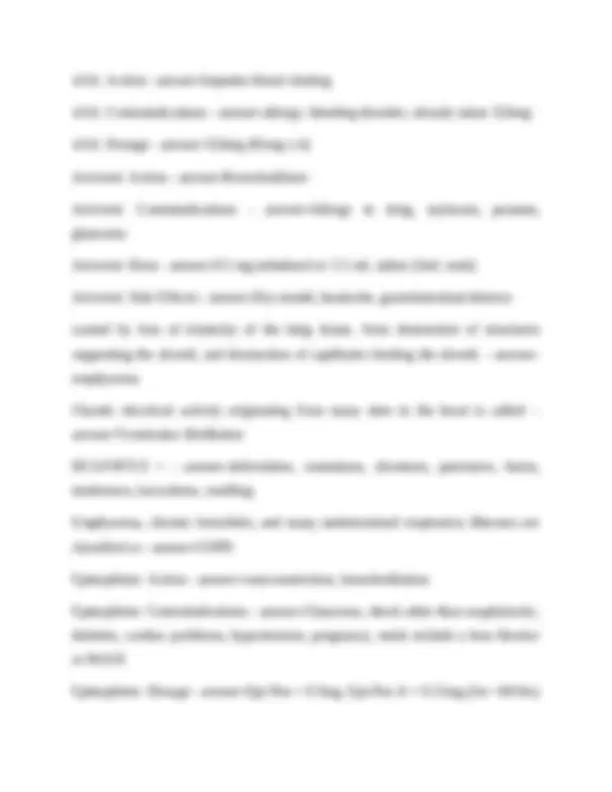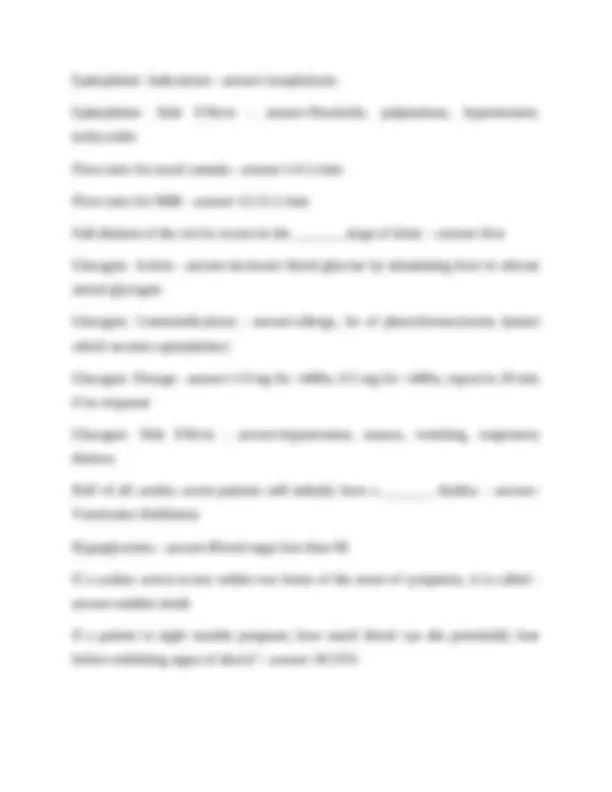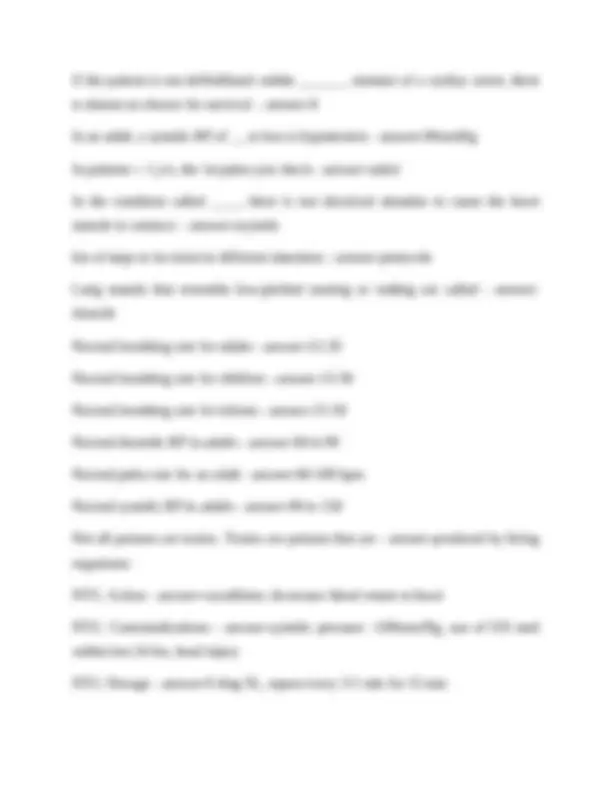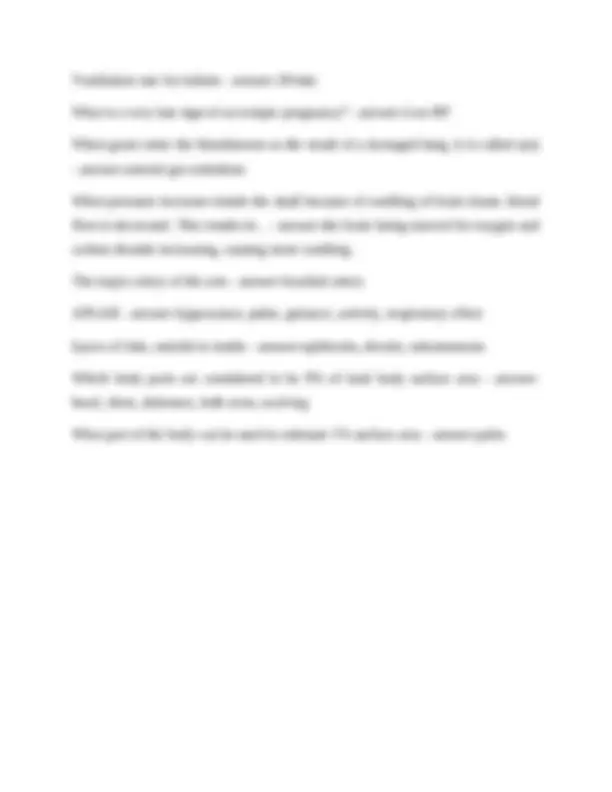






Study with the several resources on Docsity

Earn points by helping other students or get them with a premium plan


Prepare for your exams
Study with the several resources on Docsity

Earn points to download
Earn points by helping other students or get them with a premium plan
Community
Ask the community for help and clear up your study doubts
Discover the best universities in your country according to Docsity users
Free resources
Download our free guides on studying techniques, anxiety management strategies, and thesis advice from Docsity tutors
A comprehensive study guide or reference material for the emt (emergency medical technician) national registry exam. It covers a wide range of topics related to emergency medical care, including vital signs, respiratory conditions, shock, cardiac arrest, medication administration, and various other medical emergencies. Detailed answers to numerous multiple-choice questions, making it a valuable resource for emt students and professionals preparing for the national registry exam. The level of detail and the breadth of topics covered suggest that this document could be useful for both exam preparation and as a general reference guide for emts in the field.
Typology: Exams
1 / 8

This page cannot be seen from the preview
Don't miss anything!





3 effects of intracranial pressure on vital signs - answer-bradycardia, irregular breathing, hypertension ___ ___ is part of a syndrome called chronic obstructive pulmonary disease (COPD) - answer-chronic bronchitis ___ ___ is usually caused by viruses or bacteria and may last several days or weeks. - answer-Acute bronchitis a group of diseases characterized by the pathological limitation of airflow in the airway that is not fully reversible. - answer-COPD A late sign of shock is: - answer-decreased blood pressure A PASG is contraindicated if the patient presents with cardiogenic shock or _______. - answer-abnormal lung sounds a policy or protocol issued by a medical director that authorizes EMTs to perform particular skills in certain situations - answer-standing orders A sign of breathing difficulty in children is a decrease in ___ ___. - answer-pulse rate A sudden loss of _______ of blood is considered serious in an average adult. - answer-1000cc
A thrombus which has broken loose, moving with blood flow, is called - answer-an embolism A weakened section of an arterial wall that begins to dilate is known as a(n) - answer-aneurysm Activated Charcoal: Contraindications - answer-Poor LOC, vomiting Activated Charcoal: Dosage - answer-1 g/kg of body weight, adults usually 25- 50g, children 12.5-25g Activated Charcoal: Side Effects - answer-Constipation, nausea, vomiting, bowel obstruction After delivering your first shock with an AED, the patient is still pulseless, you should next - answer-perform two minutes or 5 cycles of CPR Albuterol: Action - answer-Bronchodilator Albuterol: Contraindications - answer-Allergy Albuterol: Dose - answer-2.5 mg nebulized with 2.5 mL saline (for a total of 3mL) Albuterol: Indications - answer-Acute bronchospasm due to asthma or COPD Albuterol: Side effects - answer-Headache, tachycardia, hypertension An example of a shockable rhythm - answer-pulseless ventricular tachycardia An infant or child patient who exhibits wheezing, increased breathing effort on exhalation, or rapid breathing without stridor probably has: - answer-A lower- airway disease an inflammation of the bronchi (medium-size airways) in the lungs - answer- bronchitis
Epinephrine: Indications - answer-Anaphylaxis Epinephrine: Side Effects - answer-Headache, palpitations, hypertension, tachycardia Flow rates for nasal cannula - answer-1-6 L/min Flow rates for NRB - answer-12-15 L/min Full dilation of the cervix occurs in the _______ stage of labor. - answer-first Glucagon: Action - answer-increases blood glucose by stimulating liver to release stored glycogen Glucagon: Contraindications - answer-allergy, hx of pheochromocytoma (tumor which secretes epinephrine) Glucagon: Dosage - answer-1.0 mg for >44lbs, 0.5 mg for <44lbs, repeat in 20 min if no response Glucagon: Side Effects - answer-hypotension, nausea, vomiting, respiratory distress Half of all cardiac arrest patients will initially have a _______ rhythm. - answer- Ventricular fibrillation Hypoglycemia - answer-Blood sugar less than 60 If a cardiac arrest occurs within two hours of the onset of symptoms, it is called - answer-sudden death If a patient is eight months pregnant, how much blood can she potentially lose before exhibiting signs of shock? - answer-30-35%
If the patient is not defibrillated within _______ minutes of a cardiac arrest, there is almost no chance for survival. - answer- In an adult, a systolic BP of __ or less is hypotensive - answer-90mmHg In patients > 1 y/o, the 1st pulse you check - answer-radial In the condition called ____, there is not electrical stimulus to cause the heart muscle to contract. - answer-asystole list of steps to be taken in different situations - answer-protocols Lung sounds that resemble low-pitched snoring or rattling are called - answer- rhonchi Normal breathing rate for adults - answer-12- Normal breathing rate for children - answer-15- Normal breathing rate for infants - answer-25- Normal diastolic BP in adults - answer-60 to 90 Normal pulse rate for an adult - answer-60-100 bpm Normal systolic BP in adults - answer-90 to 150 Not all poisons are toxins. Toxins are poisons that are - answer-produced by living organisms NTG: Action - answer-vasodilator, decreases blood return to heart NTG: Contraindications - answer-systolic pressure <100mm/Hg, use of ED med within last 24 hrs, head injury NTG: Dosage - answer-0.4mg SL, repeat every 3-5 min for 15 min
the amount of air breathed in during each respiration multiplied by breaths/minute
Ventilation rate for infants - answer-20/min What is a very late sign of an ectopic pregnancy? - answer-Low BP When gases enter the bloodstream as the result of a damaged lung, it is called a(n)